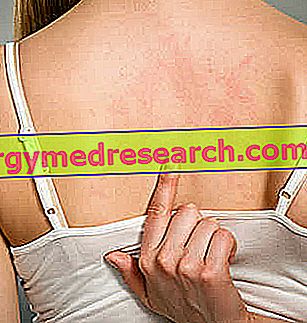Generality
Cholinergic urticaria is a skin disorder that manifests itself in response to a hot thermal stimulus and that, therefore, does not depend on causes of an allergic nature.

It is quite common that patients suffering from cholinergic urticaria also suffer from other forms of physical urticaria, sometimes triggered by stimuli of the same nature. Therefore, it is not impossible for a patient suffering from cholinergic urticaria to suffer at the same time from cold urticaria, pressure urticaria or aquagenic urticaria.
The treatment of cholinergic urticaria - although in some cases it is not necessary - involves the administration of antihistamine drugs. However, as with many other diseases, prevention remains the best cure currently available.
What is that
What is Colinergic Urticaria?
Cholinergic urticaria is a form of generalized urticaria induced by events that induce an increase in body temperature such as to activate the sweating reflex: it is the case, for example, of exposure to hot climates, intense physical effort or any other event capable of causing a stimulation of the cholinergic endings.
Incidence
Cholinergic urticaria occurs indifferently in individuals of both sexes, with a higher incidence in adolescents and young adults. However, this does not mean that it can also affect older people.
Causes
What are the Causes and Factors Triggering Colinergic Urticaria?
As mentioned, cholinergic urticaria occurs as a result of a physical stimulus, generally identified with heat, which causes an increase in body temperature. In reality, the actual trigger seems to be the resulting sweating.
Therefore, cholinergic urticaria can occur following any event or activity capable of causing activation of the sweating reflex, including:
- Intense physical exercise;
- Hot showers or baths;
- Saunas and Turkish baths;
- Diving in very hot water (for example, in thermal waters);
- Exposure to a very hot climate (high ambient temperature);
- Strong emotional stresses;
- Consumption of very spicy foods and / or alcoholic beverages (less frequent).
However, it is important to point out that each patient responds strictly to the aforementioned triggers according to their sensitivity.
Risk Factors for Colinergic Urticaria
Although cholinergic urticaria can occur in any individual, patients suffering from pathologies such as chronic urticaria, asthma, rhinitis, atopic dermatitis or hypohydrosis, are more likely to develop the disorder.
Other Causes
In addition to the involvement of cholinergic endings and sweating, in the etiology of cholinergic urticaria there is also the involvement of the immune system. According to some studies, in fact, a decisive role in the onset of the disorder is played by the activity of the mast cells and the consequent release of histamine operated by them. At the same time, there appears to be also the involvement of a neutrophilic and eosinophilic component.
Signs and Symptoms
Cholinergic urticaria is manifested by the appearance of small itchy red wheals with a diameter of 1-4 mm, which are mainly located on the upper part of the trunk, on the arms and sometimes also on the face; while the palms of the hands and the armpits are usually spared.
The aforementioned skin lesions appear within 10 minutes from the thermal stimulus and the consequent sweating, and last for a variable time from thirty minutes to three hours. After this time, a refractory period follows (ie a period in which cholinergic urticaria no longer manifests itself, not even in response to its triggering factors) whose duration varies from 8 to 24 hours.
However, generally, the severity of the aforementioned manifestations depends on the extent of sweating.
Systemic Symptoms
In addition to skin symptoms, patients suffering from cholinergic urticaria may also experience systemic symptoms, such as:
- Headache;
- Abdominal cramps;
- Diarrhea;
- Increased salivation;
- Decreased blood pressure;
- Fainting;
- Shortness of breath;
- Wheezing breath;
- Dyspnoea;
- Cough;
- Accelerated heart beat.
Diagnosis
The diagnosis of cholinergic urticaria can be made by the dermatologist or allergist who - in addition to using the information provided by the patient (type of activity performed at the time of the onset of the disorder, description of skin lesions, duration of symptoms, etc.) - can perform some specific tests.
Stress Head
It is the test that is performed most frequently. It consists in subjecting the patient to an effort in a generally warm environment, for example, by the use of an exercise bike or a treadmill, or by performing any physical exercise. Regardless of the type of effort, it must be continued until sweating is activated. The test is positive if, within 10-15 minutes, the typical skin lesions of cholinergic urticaria appear.
Diving in Hot Bath
It is a test that involves immersing the patient in a hot bath at a temperature of 40 ° C for the time necessary to obtain an increase in body temperature of 7 ° C.
Stay in the cabin of PUVA therapy
This test requires the patient to remain inside a PUVA therapy cabin for at least 10 minutes. The subject must be dressed and must perform some movement in order to activate sweating.
Please note
In the case of a positive stress test, after 24 hours, it is possible to perform a test with immersion in a hot bath in order to confirm the presence of cholinergic urticaria, differentiating it in this way from anaphylaxis induced by stress.
The use of these tests is very important to make a correct diagnosis and be able to intervene on the disorder in an appropriate manner.
The task of the specialist, in fact, is precisely to determine whether the patient really suffers from cholinergic urticaria, excluding the possible presence of other pathologies with similar clinical manifestations, such as:
- Acute or chronic urticaria;
- Pressure urticaria;
- Solar urticaria;
- Stress-induced anaphylaxis;
- Aquagenic urticaria;
- Adrenergic urticaria.
Clinical variants
Clinical variants of the Colinergic Urticaria
The following skin disorders can be considered as clinical variants of cholinergic urticaria:
- Cholinergic erythema : it is a rather rare variant characterized by the appearance of erythematous pruritic skin lesions, which are located in the same areas usually affected by cholinergic urticaria.
- Cholinergic dermographism: also known as dermographic urticaria, this disorder is characterized by the appearance of pruritic pomfoid skin lesions, which are arranged linearly. The triggering cause is due to a thermal stimulus followed by pressure, rubbing or rubbing. The symptomatology can be induced, for example, by the use of too tight clothing during sports activity.
- Cholinergic urticaria induced by cold : it is a type of cholinergic urticaria triggered by exposure to cold air.
- Cholinergic itching: Cholinergic pruritus is intended as a subclinical form of cholinergic urticaria.
Treatment
In some cases, cholinergic urticaria does not require treatment, since the symptoms are mild and tend to disappear within a few hours.
However, if the symptoms were particularly severe and debilitating for the patient, the doctor may decide to resort to drug therapy.
The pharmacological treatment of cholinergic urticaria involves the administration of antihistamine drugs. In case of no response to these medicines, the specialist can prescribe the administration of drugs able to suppress the immune system (such as, for example, corticosteroids).
However, among the main antihistamines used in the treatment of cholinergic urticaria, we recall cetirizine and loratadine .
Patients with both cholinergic urticaria and cold urticaria, on the other hand, can benefit from taking ketotifen (another antihistamine).
Prevention
Useful Tips to Prevent Colinergic Urticaria
Since the pharmacological treatment is not able to completely eliminate the pathology, but is useful only to treat and reduce the symptoms, the best cure for cholinergic urticaria is prevention.
Once the predisposition for the development of this disorder has been established, patients should - whenever possible - avoid the triggers. To do this, it may be enough to make some changes to your lifestyle:
- Avoid bathing or too hot showers;
- Avoid saunas and Turkish baths;
- Avoid wearing clothes that are too warm, too tight and / or synthetic, which can promote sweating;
- Avoid taking excessively spicy foods and / or alcoholic beverages;
- If possible, limit emotional stress.
If the triggering factors cannot be avoided, it is possible to try to prevent the occurrence of cholinergic urticaria by cooling the skin, for example, by performing showers or compresses with cold water, or by applying ice.



